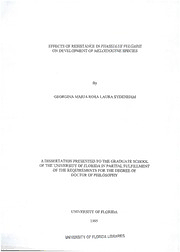
Effects of resistance in "Phaseolus vulgaris" on development of "Meloidogyne" species PDF
Preview Effects of resistance in "Phaseolus vulgaris" on development of "Meloidogyne" species
EFFECTSOFRESISTANCEJNPHASEOLUSVULGARIS ONDEVELOPMENTOVMELOIDOGYNESPECIES By GEORGINAMARIA-ROSALAURASYDENHAM ADISSERTATIONPRESENTEDTOTHEGRADUATESCHOOL OFTHEUNIVERSITYOFFLORIDAINPARTIALFULFILLMENT OFTHEREQUIREMENTSFORTHEDEGREEOF DOCTOROFPHILOSOPHY UNIVERSITYOFFLORIDA 1995 UNIVERSITYOFFLORIDALBRARtES ACKNOWLEDGMENTS Iwouldliketoexpressmythankstothemembersofmyadvisorycommittee, Dr.R.A.Dunn,Dr.R.McSorley,Dr.D.J.Mitchell,andDr.G.W.Simone,fortheir supportandguidancethroughoutmydoctorateprogram IamgratefijltoDr.Dunnfor hisfinancialsupportandtheopportunitiestotraveltoHondurasandBraziltopresent myresearch. MythanksgotoDr.Simoneforhisencouragementtoenjoythese"best daysofmylife." MyspecialthanksgotoDr.McSorleyandDr. Mitchellfortheir continuousencouragement, theirexperienceandknowledge, andtheirtimespentin discussionsdirectlyassociatedwithmyprojectsandphilosophicalviewsontherolesof scientistsandeducatorsinaworldsociety. Iwouldliketothankmyfamilyfortheiracceptanceandsupportofmydecision tostayintheUSA,andfortheirwarmwelcomesonmyvisitshome. Thanksalsogoto allmyfriendswhohavelistenedandencouragedmethroughoutthisdegree.Finally,I wouldliketothankStephenRobinson,especially,forhistirelessreadingoffirstdrafts, andforhisencouragement,support,laughter,andlove. ii 1 TABLEOFCONTENTS page ACKNOWLEDGMENTS ii LISTOFTABLES v LISTOFFIGURES vii ABSTRACT ix CHAPTER1:REVIEWOFLITERATURE 1 CHAPTER2:EFFECTSOFRESISTANCEINGERMPLASMOF PHASEOLUSVULGARISONPENETRATIONANDDEVELOPMENT OFMELOIDOGYNEINCOGNITARACE2ANDMELOIDOGYNE ARENARIARACE1 9 Introduction 9 MaterialsandMethods 1 Results 14 GeneSystem1 14 GeneSystem2 17 Discussion 20 CHAPTER3:EFFECTSOFTEMPERATUREONRESISTANCEIN NEMASNAPANDG1805BEANANDONDEVELOPMENTOF MELOIDOGYNEINCOGNITARACE2 MELOIDOGYNE ARENARIARACE1 44 Introduction 44 MaterialsandMethods 46 GeneSystem1andGeneSystem2 46 HighTemperatureExperiments1and2 48 Results 49 GeneSystem1 49 GeneSystem2 53 HighTemperatureExperiments1 57 HighTemperatureExperiments2 57 Discussion 5g iii page CHAPTER4:RESEARCHSUMMARYANDCONCLUSIONS 85 APPENDIXA:RESISTANCEINGERMPLASMOFPHASEOLUS VULGARISTOFLORIDAPOPULATIONSOFMELOIDOGYNE SPECIES 87 Introduction 87 MaterialsandMethods 88 GeneSystem1 88 GeneSystem2 90 Results 91 GeneSystem1 91 GeneSystem2 92 Discussion 93 APPENDIXB:HISTOPATHOLOGYOVMELOIDOGYNEARENARIA RACE1INFECTIONINRESISTANTANDSUSCEPTIBLE PHASEOLUSVULGARISGERMPLkSU 104 Introduction 104 MaterialsandMethods 105 Results 106 LISTOFREFERENCES 109 BIOGRAPHICALSKETCH 115 iv LISTOFTABLES Table page 2-1pl.aGntasllinioncduelxatraetdinmgtohfMroeoltosiyosdtoegmysneofinBcloagcnkitVaalreanctei2neandNemasnapbean 24 2-2. NumbersofeggsofMeloidogyneincognitarace2extractedfromthe rootsystemsofBlackValentineandNemasnapbeanplants,juveniles hatchingfromtheeggsafter10days,andeggsperfemale 25 2-3. LeafareasofBlackValentineandNemasnapbeanplantsuninoculated (NN)orinoculatedwithMeloidogyneincognitarace2(Mil) 26 2-4. EnergycontentofplanttissuesofBlackValentineandNemasnapbean plantsuninoculated(NN)orinoculatedwithMeloidogyneincognitarace2 (Mil) 27 2-5. GallindexratingofrootsystemsofBlackValentineandG1805bean plantsinoculatedwithMeloidogynearenariarace1 28 2-6. Numbersofeggs Meloidogynearenariarace1extractedfromthe rootsystemsofBlackValentineandG1805beanplants,juvenileshatching fromtheeggsafter10days,andeggsperfemale 29 2-7. LeafareasofBlackValentineandG1805beanplantsuninoculated(NN) orinoculatedwithMeloidogynearenariarace1(Mai) 30 2-8. EnergycontentofplanttissuesofBlackValentineandG1805bean plantsuninoculated(NN)orinoculatedwithMeloidogynearenariarace1 (Mai) 31 3-1. NumbersofmalesofMeloidogyneincognitarace2inrootsystemsof susceptibleBlackValentineandresistantNemasnapcommonbean(gene system1)incubatedatthepre-inoculationconditioningtemperaturesand post-inoculationincubationtemperaturesof24°C,and28°C 62 3-2. NumbersofMeloidogyneincognitarace2infourdevelopmentalstages inrootsystemsofsusceptibleBlackValentineandresistantNemasnap commonbean(genesystem1)incubatedattemperaturesof30''Cor32°C 63 V Table page 3-3. NumbersofMeloidogymarenariarace1infourdevelopmentalstages inrootsystemsofsusceptibleBlackValentineandresistantG1805common bean(genesystem2)incubatedattemperaturesof30°Cor32°C 64 A-1. ResistanceinPhaseolusvulgarisgermplasmtoMeloidogynespeciesand races 95 A-2. OriginsandsourcesofPhaseolusvulgarisgermplasm 96 A-3. Sources Meloidogynespecies 97 A-4. ResistanceinPhaseolusvulgarisgermplasmcontaininggenesystem1to aFloridapopulation Meloidogyneincognitarace3 98 A-5.ResistanceinPhaseolusvulgarisgermplasmcontaininggenesystem1toa FloridaandaCaliforniapopulationofMeloidogyneincognitarace3 99 A-6.ResistanceinPhaseolusvulgarisgermplasmcontaininggenesystem1toa FloridapopulationofMeloidogyneincognitarace2 100 A-7.ResistanceinPhaseolusvulgarisgermplasmcontaininggenesystem2toa FloridapopulationofMeloidogynejavanica 101 A-8.ResistanceinPhaseolusvulgarisgermplasmcontaininggenesystem2toa FloridapopulationofMeloidogynearenariarace1 102 A-9.ResistanceinPhaseolusvulgarisgermplasmcontaininggenesystem2toa FloridapopulationofMeloidogynearenariarace2 103 B-1.Ethanol(EtOH)andtertiarybutylalcohol(TBA)dehydrationseries 107 B-2.Mineraloil,waxandparaffininfiltrationseries 108 vi LISTOFFIGURES Figure page 2-1. PenetrationanddevelopmentofMeloidogyneincognitarace2insusceptible BlackValentineandresistantNemasnapcommonbeangermplasm(genesystem1, trials1and2 33 2-2. PercentageofthepopulationofMeloidogyneincognitarace2infour developmentalstagesinrootsystemsofsusceptibleBlackValentineandresistant Nemasnapcommonbeangermplasm(genesystem1,trials1and2) 35 2-3. TotalplantdryweightsofBlackValentine(BV)andNemasnap(NS) uninoculated(NN)orinoculatedwithMeloidogyneincognitarace2{Mil)(gene system1,trials1and2) 37 2-4. PenetrationanddevelopmentofMeloidogynearenariarace1insusceptible BlackValentineandresistantG1805commonbeangermplasm(genesystem2, trials1and2) 39 2-5. PercentageofthepopulationofMeloidogynearenariarace1infour developmentalstagesinrootsystemsofsusceptibleBlackValentineandresistant G1805commonbeangermplasm(genesystem2,trials1and2) 41 2-6. TotalplantdryweightsofBlackValentine(BV)andG1805(G)uninoculated (NN)orinoculatedwithMeloidogynearenariarace1(Ma\)(genesystem2,trials 1and2) 43 3-1. TotalpopulationsofMeloidogyneincognitarace2insusceptibleBlack ValentineandresistantNemasnapcommonbeangermplasmatfourtemperature regimesofpre-inoculation/post-inoculationtemperaturesof24/24°C,24/28°C, 28/24''C,and28/28''C(genesystem1,trials1and2) 66 3-2Effectsofpre-inoculationtemperatures(24^and28°C)onpenetrationand developmentofMeloidogyneincognitarace2insusceptibleBlackValentineand resistantNemasnapcommonbeangermplasm(genesystem1,trial1) 68 3-3. Effectsofpre-inoculationtemperatures(24°Cand28T)onpenetrationand developmentofMeloidogyneincognitarace2insusceptibleBlackValentineand resistantNemasnapcommonbeangermplasm(genesystem1,trial2) 70 vu Figure page 3-4Effectsofpost-inoculationtemperatures(24°Cand28°C)onpenetrationand developmentofMeloidogyneincognitarace2insusceptibleBlackValentineand resistantNemasnapcommonbeangermplasm(genesystem1,trial1) 72 3-5. Effectsofpost-inoculationtemperatures(24°Cand28''C)onpenetrationand developmentofMeloidogyneincognitarace2insusceptibleBlackValentineand resistantNemasnapcommonbeangermplasm(genesystem1,trial2) 74 3-6. TotalpopulationsofMeloidogynearenariarace1insusceptibleBlackValentine andresistantG1805commonbeanatfourtemperatureregimesofpre- inoculation/post-inoculationtemperaturesof24/24°C,24/28°C,28/24°C,and 28/28''C(genesystem2,trials1and2) 76 3-7. Effectsofpre-inoculationtemperatures(24°Cand28°C)onpenetration,and developmentofMeloidogynearenariarace1insusceptibleBlackValentineand resistantG1805commonbeangermplasm(genesystem2,trial1) 78 3-8. Effectsofpre-inoculationtemperatures(24°Cand28°C)onpenetration,and developmentofMeloidogynearenariarace1insusceptibleBlackValentineand resistantG1805commonbeangermplasm(genesystem2,trial2) 80 3-9. Effectsofpost-inoculationtemperatures(24°Cand28"C)onpenetrationand developmentofMeloidogynearenariarace1insusceptibleBlackValentineand resistantG1805commonbeangermplasm(genesystem2,trial1) 82 3-10. Effectsofpost-inoculationtemperatures(24^and28°C)onpenetrationand developmentofMeloidogynearenariarace1insusceptibleBlackValentineand resistantG1805commonbeangermplasm(genesystem2,trial2) 84 viii AbstractofDissertationPresentedtotheGraduateSchool oftheUniversityofFloridainPartialFulfillmentofthe RequirementsfortheDegreeofDoctorofPhilosophy EFFECTSOFRESISTANCEINPHASEOLUSVULGARIS ONDEVELOPMENTOFMELOIDOGYNESPECIES By GeorginaMaria-RosaLauraSydenham December,1995 Chairman: Dr.R.A,Dunn MajorDepartment: EntomologyandNematology Root-knot nematodes, Meloidogyne spp., are major limiting factors in the production ofcommon bean, Phaseolus vulgaris. Use of resistant P. vulgaris germplasm has potential for management ofroot-knot nematodes. Mechanisms of resistanceoftwogeneticresistancesystemsandeffectsoftemperatureonresistance expression were studied using a susceptible cultivar 'Black Valentine' and either M resistantcultivar'Nemasnap'(genesystem1)with incognitarace2,orgermplasm M G1805(genesystem2)with arenariarace1. Mechanismsofresistanceandeffects ofpre-andpost-inoculationtemperatures(24°Cand28°C)wereevaluatedatspecific harvestdatesbydeterminingnematodepopulationswithinrootsandtheproportionof eachpopulationwithindistinctdevelopmentalstages. Sincesimilarnumbersofjuvenilespenetratedrootsofresistantplantscompared withsusceptibleBlackValentine, pre-penetrationmechanismsofresistancewerenot expressedineitherNemasnaporG1805. Resistancewasexpressedbypost-penetration ix mechanisms, which resulted in smallerpopulations ofnematodes and their delayed developmentinresistantplantscomparedwithsusceptibleplants. Resistancewaseffectiveatalltemperatureregimesexamined,withsmaller populationsofnematodesinrootsofNemasnapandG1805comparedtoBlack Valentine.Pre-inoculationtemperature,perse,didnotmodifyresistanceexpressionin M NemasnaporG1805tolaterinfectionsby incognitaoxM.arenaria,respectively. However,post-inoculationtemperatureshadpronouncedeffectsonthedevelopmentof Meloidogynespp.inallgenotypes.Themorerapiddevelopmentofnematodestoadult stagesatthehighertemperatureof28°Ccomparedwith24°C,inboththeresistantand thesusceptiblegermplasms,indicatesthattheeffectofpost-inoculationtemperatureon nematodedevelopmentisdirect,ratherthanviaresistanceexpressionofeithergene system1orgenesystem2. Resultsofstudiesathighertemperaturesdemonstratedthat resistanceinNemasnapandinG1805alsowasstableatSOTand32°C. TestswithFloridapopulationsofroot-knotnematodesidentifiedpotentially M M virulentpathotypesof incognitarace3and javanicaintheirresistantP.vulgaris hostscontaininggenesystems1and2,respectively. Thusitiscriticaltoassessthe performanceofresistantgermplasmtoawiderangeofgeographicallylocalized populationsofnematodespecies.
